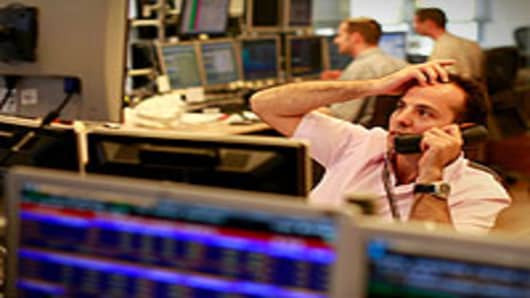Asian stocks dropped on Tuesday, with the Kospi amongst the worst performers, down 9 percent at one point in the mid-morning session, before recovering on bargain hunting. A number of experts told CNBC the selling was likely to continue even as some pointed to the first silver linings.
Aadil Ebrahim, managing director and portfolio manager at Bowen Capital Management in Hong Kong, said the firm hadn't added to any of their portfolios on the volatile day of trading.
"Bottom fishing can be dangerous when investors are liquidating their portfolios," Ebrahim told CNBC. "While we agree that there has been a lot of shorting going on, the steep declines in markets like Korea and Taiwan point to larger funds reducing their long positions."
Ebrahim said the firm would wait till the markets stabilize before deciding whether to buy. In the meantime, he said the fund had been taking profits on some of its index short positions in Hong Kong and India.
He added, that if the markets rallied in the near-term, the firm would decide whether to add to the shorts or to close out the positions.
Darryl Guppy of Guppy Traders told CNBC his analysis of the charts indicates the volatile times aren’t over yet.
“The important thing is, when we look at the Dow, the downside target for that head and shoulders pattern is at 10600, but the long-term pattern for that is 9700 and that’s achievable, because if we look at what’s happening with the Nasdaq, we see the downside target on the Nasdaq, which is 2370, has already been exceeded, and that gives us a longer-term downside target for the Nasdaq near 2100,” said Guppy.
Nymex crude prices dropped below $80 a barrel in the Asian trading session on Tuesday, and Bill Smead, CEO of Smead Capital Management said the drop in gasoline prices would be a big boost for the U.S. consumer and the broader economy.The question that experts are now grappling with is whether the fear is being restricted mainly to the financial markets or if it was being felt more broadly across the economy.
“I really think the downdraft in equities today, as well as in the past week or so, really comes on the heels of falling (manufacturing) numbers in the US and China, slowing growth in Europe, and a lot of information coming out of second quarter earnings calls indicating that a lot of key industrial companies [are] seeing slowdowns in their business across the globe,” said Patrick Dorsey of the Sanibel Captiva Trust Company.
Meanwhile, China reported industrial output that grew at a slightly slower pace in July than in previous months, but the 14 percent growth rate over the previous year was still extremely strong and enough to instill confidence in those worried about a sharp slowdown.
But speaking before the data was released, Matthew Grossman, Chief Equity Market Strategist at Adam Mesh Trading Group said the markets' focus wouldn't be on China but rather on the debt problems in Europe and the U.S.
"I know China has a big number coming out today but I don't think that's where the focus is," he said. "I think people are focused on 2 things right now and that's what's going on in Europe, and that's what's going on in the United States."
Other experts say the selling was beginning to create value for investors willing to take some risks.
“This isn’t the best time to be thinking about going down the risk curve," Michael McLaughlin, Head of Credit Trading, Macquarie Group told CNBC. "But what I would try to tell our clients, and people who are sophisticated investors, on these weaknesses you have to take advantage of the prices we see and based on strong fundamental research, you can find some babies amidst the bath water that’s been thrown out here.”


